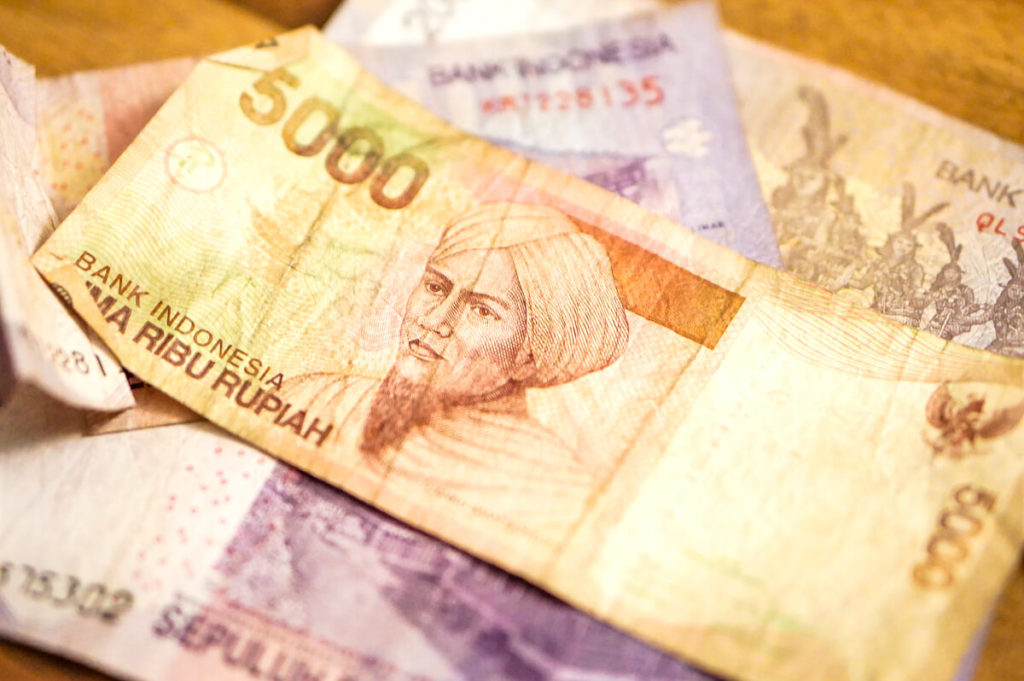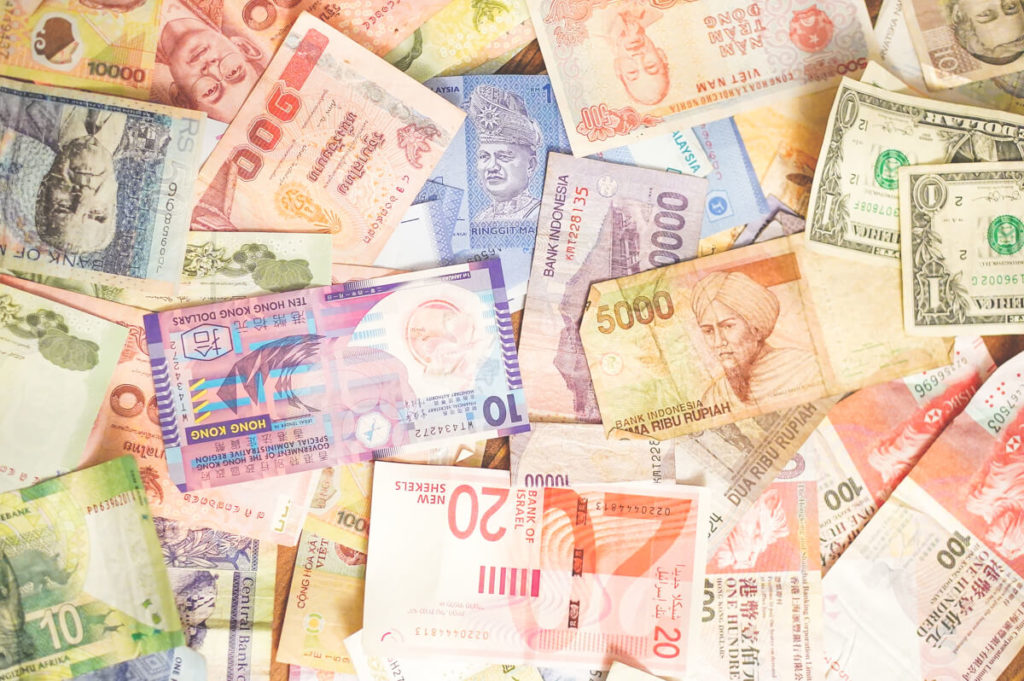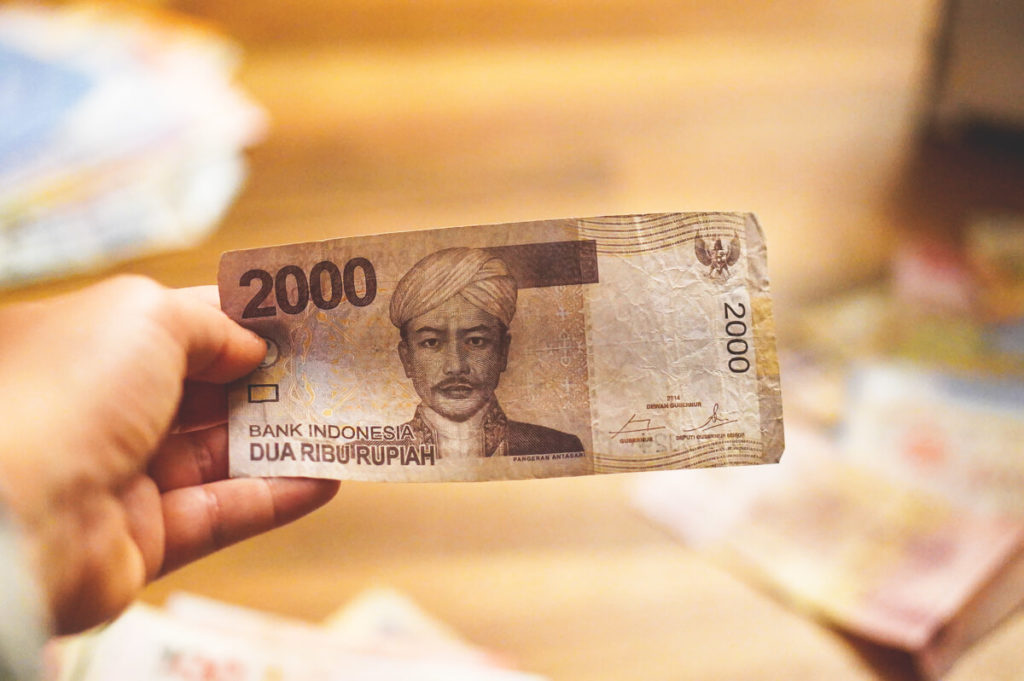Have you long dreamed of strolling through lush green rice fields, enjoying a delicious fresh smoothie during a break in one of Bali’s cozy cafes, or have you always wanted to explore Indonesia’s temples and unique culture? If you’re currently preparing for your trip to Indonesia, you should definitely familiarize yourself with the currency for Indonesia and local payments beforehand. I’ve summarized all the important information in the following article so you can get an idea of what it’s like.
- Currency in Indonesia
- Withdrawing money in Indonesia
- Fees for withdrawing money in Indonesia
- Exchanging money locally
- Paying with a credit card
- The best credit card for Indonesia
- Prices in Indonesia
- Currency in Indonesia – My conclusion
- Travel reading
Currency in Indonesia
In Indonesia, you pay with Indonesian Rupiah (IDR), which has been the official currency since 1949. As with us, coins and banknotes are used in everyday life. You can get coins in denominations of 25, 50, 100, 200, and 1,000 rupiah, although you’ll hardly find the 25 and 50 rupiah in use anymore. Banknotes come in denominations of 100, 500, 1,000, 5,000, 10,000, 20,000, 50,000, and 100,000.
As you can see, the numbers are quite high compared to the euro, and it’s easy to lose track. I therefore recommend using a currency converter app on your smartphone so you can quickly check whether your conversion is correct when making a booking or shopping in person. Currently, you can get around 15,572 rupiah for €1 (as of November 2019).
Withdrawing money in Indonesia
I’ve backpacked in Indonesia several times myself and never had any problems withdrawing cash, both on the island of Java and on Bali. Since Indonesia is geared towards vacationers, tourists, and backpackers, you’ll find ATMs in all major towns and even in smaller ones like Ubud on Bali where you can easily withdraw money. However, you should get a credit card before your trip. You can easily withdraw money in Indonesia with VISA and Mastercard. American Express and Diners Club cards are also accepted at most ATMs.

You can even withdraw money with your debit card, but expect high fees (up to €10). Also note that ATMs in Indonesia usually have a limit of around 1.5 million rupiah per withdrawal, or about €96. Bolle and Marco also recommend carrying more than one credit card. Something can always happen (your card is swallowed by the ATM, your card is stolen), so you should have a Plan B and a Plan C to get money.
Skimming
IMPORTANT: The issue of skimming should not be underestimated in Indonesia. ATMs attach special card readers, which then read your card data. So check your account balance regularly (if possible). If an ATM seems suspicious, you shouldn’t withdraw money from it. In general, use ATMs in banks, which are usually monitored.
Fees for withdrawing money in Indonesia
If you withdraw money in Indonesia using your credit or debit card at an ATM or bank, your bank in Germany will usually charge you a fee of €5 to €10, regardless of the amount withdrawn. Some banks also charge a percentage of the withdrawn amount, which is shown as a foreign transaction on your bank statement. I would therefore recommend roughly calculating what you will need in the next few days before withdrawing and then withdrawing a larger amount.
To avoid unnecessary fees, you should definitely get a fee-free travel credit card for your trip to Indonesia. Currently, you can only get your fee refunded upon request with the Santander Bank* credit card. This credit card also waives the foreign transaction fee. More information on this below. Be sure to check with your bank before your trip to see if there are any fees for card payments abroad.
Exchanging money locally
Like everywhere else in the world, you can exchange money in Indonesia directly at the airport after your arrival. However, the exchange rates at the airport are usually worse than at exchange offices in the cities. If you feel safe, you can exchange a few euros at the airport for your taxi to your hotel and then leisurely find an exchange office in the city after your arrival. You can also exchange cash at local banks. The most common banks in Indonesia are Mandiri, BDNI, Bank Central Asia, and Citibank.

No matter where you exchange your money, be sure to confirm the exchange rate beforehand, as the rates on the signs outside often don’t match the ones you’re ultimately offered. Once you’ve received your money, you should count it again. It’s not uncommon for a few bills to be missing. You should also avoid exchanging your money on the street, as these are usually dubious rip-offs. Exchanging money at home in Germany is also not advisable, as the exchange rates are significantly worse than on-site.
Paying by Credit Card
In larger cities, in many hotels, upscale restaurants, shops, or even at rental car stations, paying by credit card is easily possible. However, you should also be aware that your bank will charge you a foreign transaction fee of approximately 1 to 4% on every payment. It’s therefore worthwhile to get a free credit card (e.g., Santander Bank), as you can even get your fees refunded upon request.
In more rural areas, small cafés, and taxis, you should always carry cash with you, as paying by credit card is usually not possible there. This also applies to less developed regions. If you want to take a cashless taxi, I recommend the UBER or GOJEK apps. Works particularly well at typical tourist destinations in Indonesia!
When paying with a credit card, you should always make sure that the seller doesn’t run off with your credit card. Always keep an eye on what’s happening with your card. There’s a detailed post on the topic of security here on the blog: Security when using credit cards.
The best credit card for Indonesia
As mentioned several times, a free travel credit card is suitable for Indonesia. This allows you to easily withdraw cash (mostly) anywhere and also pay abroad. Bolle and Marco have been using the DKB* credit card for almost 6 years. If you’re an active customer, you can use the card to pay abroad and withdraw cash from ATMs free of charge.
It’s important to know that you must withdraw at least €50 per withdrawal; otherwise, fees will apply for your mini-cash option. Merchants or ATM operators may also charge additional fees for use. Unfortunately, DKB has no influence over this and will not refund these fees.
A better option is the 1plus Visa Card* from Santander Bank, which has no fees at ATMs worldwide. This card is free all year round, and you even get a 1% fuel discount at gas stations. Merchants or ATM operators may also charge a fee here.
You can have this refunded upon request. This was also possible with the DKB card until 2016. In addition, Marco and Bolle still have the N26 Mastercard* with them. This is also free and has been with us on our travels for years. More about it here: The best travel credit cards*.
Prices in Indonesia
You can travel and live very cheaply in Indonesia. Compared to Europe, this country is truly very affordable. To give you a first impression, I’ve picked out a few prices for you here:
- Hostel bed: from €5
- Simple private room: from €7
- 2-star hotel room: from €15
- Roadside food: €1-3
- Western meal: from €4
- Beer at the supermarket: €1
- Scooter rental: from €4 per day
- 1 liter of gasoline: €0.64
- Surfboard rental: from €5
- Yoga class: from €6
- Massages: from €5
- Laundry: €1 per kilo

Currency in Indonesia – My Conclusion
As you can see, a vacation in Indonesia is really very affordable. On average, you can expect to spend around €25 to €30 a day. Of course, you can get even cheaper, or you can spend a little more and enjoy a little luxury. I would definitely recommend applying for a credit card (or two) before you leave. Withdrawing cash is not a problem almost everywhere; only in rural areas should you make sure you have some cash beforehand.
I also recommend always having some bills with you for the night markets and local restaurants, as credit cards are not yet accepted everywhere here. All in all, you shouldn’t worry too much before your departure, because as you can see, there are quite a few ways to get cash and pay cashlessly in Indonesia.
Travel Reading
If you want to learn more about Lombok, Bali, and all the other islands, we recommend the great books by Melissa from the blog Indojunkie. In her shop, you’ll find, among other things, an island guide for Lombok*. Also highly recommended is the book 122 Things to Do in Bali*. In this book, you’ll learn absolutely everything you need to know about the island. We have this book at home ourselves and always enjoy leafing through it. An incredible amount of work and love went into it. Therefore, we would be thrilled if you would support their work.
Fancy a cool tour in Indonesia? Then browse through the offers from Get your Guide. Here you’ll find a good selection of different offers.
Don’t want to miss any more information?
Feel free to follow us on Facebook, Instagram, or Pinterest. You can also send us a personal message there. We always try to respond as quickly as possible. Otherwise, you can also reach us by email at any time.